Last Updated: 29th Feb, 2024
The revenue in the ride-hailing segment is projected to reach US$260,159M in 2021. Revenue is further expected to show an annual growth rate (CAGR 2021-2025) of 10.4%, resulting in a projected market volume of US$385,942M by 2025. The user penetration, which stands at 19.6% in 2021 is expected to hit 20.8% by 2025.
In a nutshell, what these stats indicate is a shift in the way people are moving around places. The rising population continues to eat away the open spaces in urban cities. With worsening traffic conditions and parking spaces going full in no time, more and more car owners are turning to on-demand taxi services for convenient travel. In light of this scenario, it’s fair to say that the future of the ride-hailing industry looks bright and promising.
While for the existing players this means improving their services and solving maximum customer pain points, for the aspiring entrepreneurs, this is an opportunity to put their unique ideas to test, and probe into the less explored areas of the ride-hailing segment to cause a market shift. But before attempting anything groundbreaking, it’s always advisable to perform due market research and analysis in advance.
If you’re wondering how to kickstart your online taxi-booking business in the right way then this blog is for you. Before we proceed to the success of Uber and the different revenue models, it’s vital to understand what a uber-like app development process entails. So let’s take a look at that first:
Key Steps Involved in Uber-Like App Development Process
The development process of a taxi booking app can be broken down into 4 steps. Here’s what it looks like:
Technical Audit & Research
First off, you have to make a list of the requirements for your uber-like app development. In case you have an existing taxi booking service you’ll only need to build an app in line with your current operations. But if you’re starting from scratch then everything will need to be planned as per your vision. In both scenarios business owners should take the opportunity to research and identify the improvements that they could offer over existing taxi booking apps.
App Documentation
Before moving on to app documentation, you’ll have decided the type of apps – native or hybrid and the platform for which they’ll be built – iOS and Android. These are questions of significant importance as they determine the absolute course of app development. Once these questions are answered and requirements have been finalized, the next step involves listing down the technical specifications of the app, the architecture and the tech stack that would be used.
Building a taxi-booking mobile app
Development can be pursued either from scratch or using a ready-made solution. In either case, the project involves a series of operations which are further divided into smaller individual tasks. These tasks are then completed based on their priority. Further unit testing is performed throughout the process to identify & resolve any logical errors.
Deploying The App
Once an app is built, it is deployed to live environments for a functionality check and performance testing on various devices. Any issues are quickly resolved to get the app ready for a market launch.
So, those are the key stages of a taxi booking app development process. Now, to put things into perspective, it’s worth looking at how the pioneering on-demand ride-booking service Uber operates and how it’s been able to disrupt the taxi industry upside down.
Lessons From Uber’s Road to Success
As per recent stats, Uber has nearly 95 million active monthly users. This easily makes it the most successful and popular player in the cab/Taxi-Booking arena. To say that startups face an uphill task when aiming to emulate Uber’s success would be an understatement. Uber’s success is derived through sustained compliance with DMAIC processes and designs. The following image gives an overview of Uber’s journey through the years.
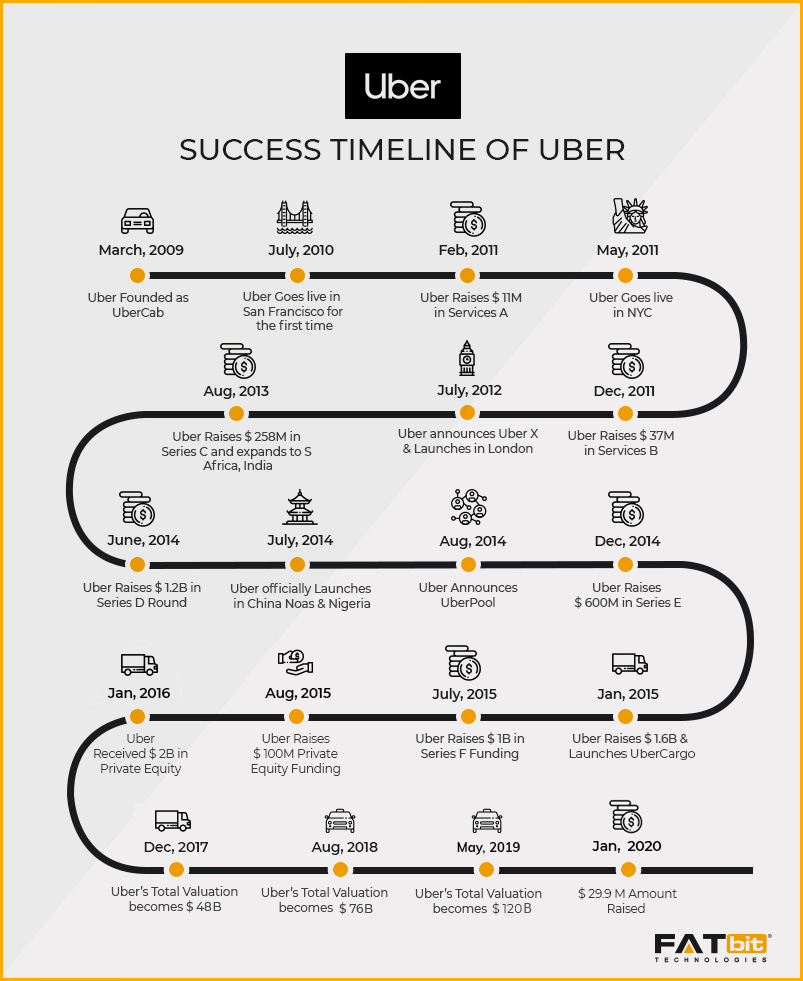
Those are the key milestones that map out Uber’s journey to success but to get a better understanding of its internal operations, we need to dive in deeper. The technology that powers Uber’s operations is encapsulated in its user-friendly duo of rider and driver mobile apps, available both on the Android and iOS platforms. The use of geolocation enables riders and drivers to find each other and use the service.
Talking of service, Uber has many levels to it to cater to a wide range of audience:
- UberX – economical option for everyday users
- UberBLACK – stylish cars for a bit of show-off
- UberSUV – large SUVs for those who care for more space
- UberLUX – cars that are all about luxury
How Uber Works?
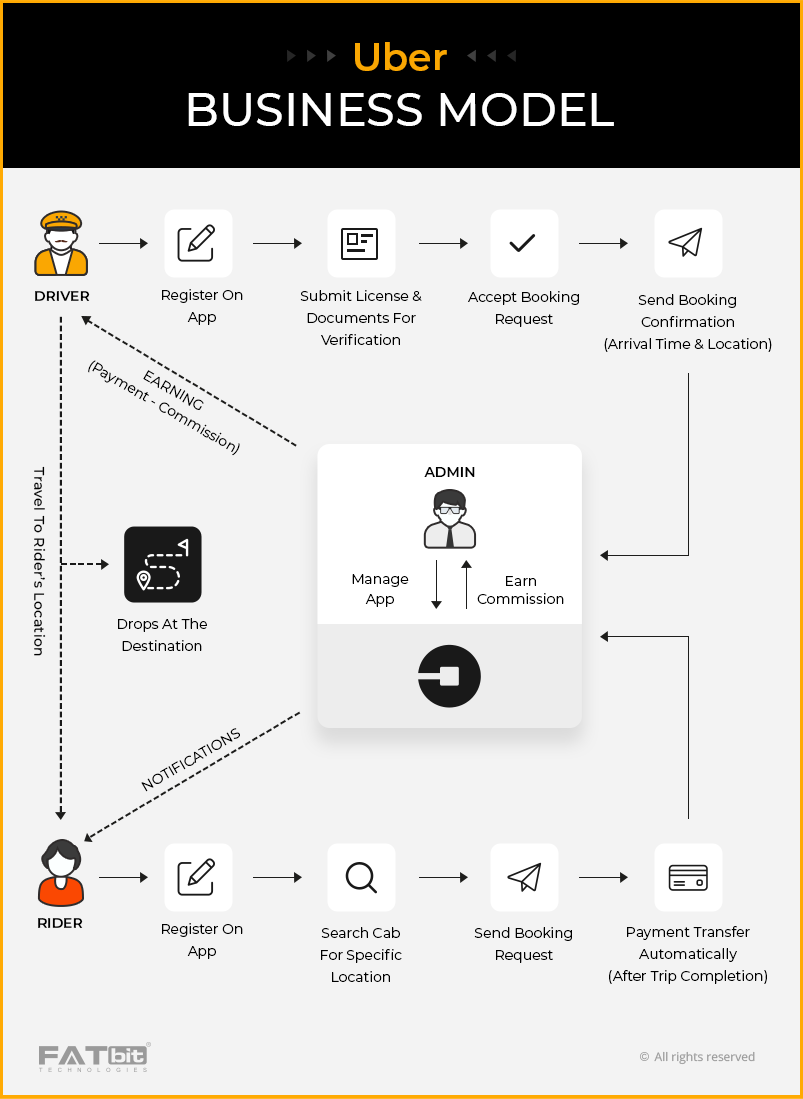 To ensure that the customer/rider can use these services in a hassle-free manner, Uber has a very simple ride-booking process in place. Here’s how it works:
To ensure that the customer/rider can use these services in a hassle-free manner, Uber has a very simple ride-booking process in place. Here’s how it works:
Request – The rider requests for a car from a specified/current location using the app. The request is sent out to the drivers in the nearby location.
Matching – The matched driver has the option to accept/cancel the request. In case, the request is rejected, it’s transferred to the next available driver.
Ride – Once a driver has accepted the ride request, the booking confirmation is sent to the rider. The rider gets an estimated arrival time and can track the driver’s location in real-time.
Payment – Payment details are shared with the rider before the booking. Payment can be made using any of the cashless methods supported by Uber.
Rating – To bring trust and reliability to its service, Uber offers users a chance to leave a rating and submit feedback of their ride experience.
What Makes Uber So Effective?
What makes this ride-booking process so simple and straightforward are the mobile apps. So, for any enthusiast planning to build an Uber-like taxi booking app, an understanding of these apps and their several features is quite crucial. The entire taxi booking platform rests on two mobile apps; a driver app for drivers who partner with the company to offer their services, and a rider app for people to book their rides on the platform. In addition to these two, there’s also an Admin panel that is needed to manage and monitor the actions on the platform. Following is a list of the basic and advanced features needed for both types of apps.
Basic Features For Rider’s App
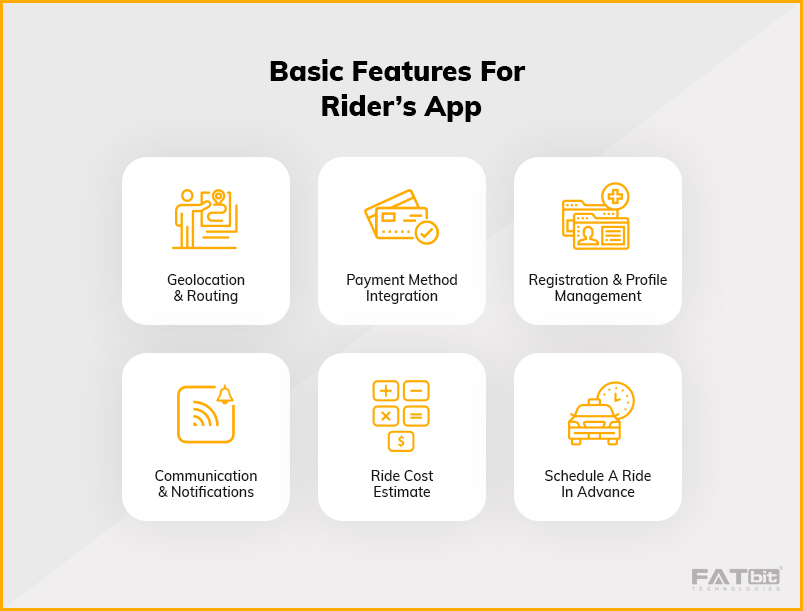
1. Geolocation and Routing
Geolocation is one of the most basic yet indispensable features in any taxi booking app like Uber. Much of the ride-booking process revolves around identifying the user’s exact location. GPS technology comes to the fore for this functionality. While to the rider on the front-end the process of dropping a pin on the map and finding the nearby drivers looks quite simple, there’s a complex amount of processing and data-sharing going on behind the scenes. From the moment the app is launched till the drop-off, a routing server works non-stop to measure the distance and run the routes.
2. Payment method Integration
Online payments have become the norm nowadays thanks to the advance in technologies. With Uber using cashless payments, this feature has come to be accepted as a standard in any type of taxi booking app. Uber offers its users a fare calculator that gives a decent estimate of the ride’s cost. This is based on the four main criteria:
- Base fare
- Cost per mile
- Cost per minute
- Safe rides fee
A payment method’s integration should be performed with due care to ensure the safety of the user’s financial data. For credit card data processing, the payment system should meet PCI compliance. Alternatively, you could opt for payment gateway providers that offer PCI compliance solutions such as Braintree or Stripe.
3. Registration & Profile Management
User registration and profile set up are quite important features in a taxi booking app as they allow you to get a real sense of your user-base. In recent years, it’s become a common practice across all categories of apps to allow user registration through Gmail or Facebook. The profile itself should allow for basic identity setup(photo, name, phone number). Finally, users should be offered a rating/review system. This allows you to gather crucial user insights, learn about their major pain points, and use that feedback to improve your service.
4. Communication & Notifications
The significance of timely communication can’t be emphasized enough in a taxi app like Uber. To make communication swift and hassle-free, Uber lets its users to text/call each other without leaving the app. Still, to keep the driver and rider on the same wavelengths the app sends out SMS, email and push notification during the key stages of the ride-booking process. For the iOS platform, push notifications are made possible with Apple Push Notification Service, as for the Android, Firebase Cloud Messaging service is used. SMS notifications can be integrated with APIs such as Twilio, Plivo and Nexmo.
5. Ride Cost Estimate
This feature allows riders to get an estimated price of their ride based on the pick-up and drop off locations. The calculation is worked out using an algorithm integrated inside the app. Different fares need to be specified if the platform offers a diverse range of vehicles for booking.
6. Schedule a Ride in Advance
Ride-scheduling is an advanced feature made popular by Uber a few years back. It allows users to book a ride in advance anywhere between 15 minutes to 30 days. This is a good feature for those who like to plan ahead of their travel. It could be part of the initial MVP release or rolled out in later updates based on user feedback.
Advanced Features For Rider’s App
Fare Splitting
Splitting of Fare isn’t a must-have feature but it can add to the appeal of a taxi booking app. This feature allows co-passengers/friends travelling together to split the total ride fare among themselves.
Basic Features For Driver’s App
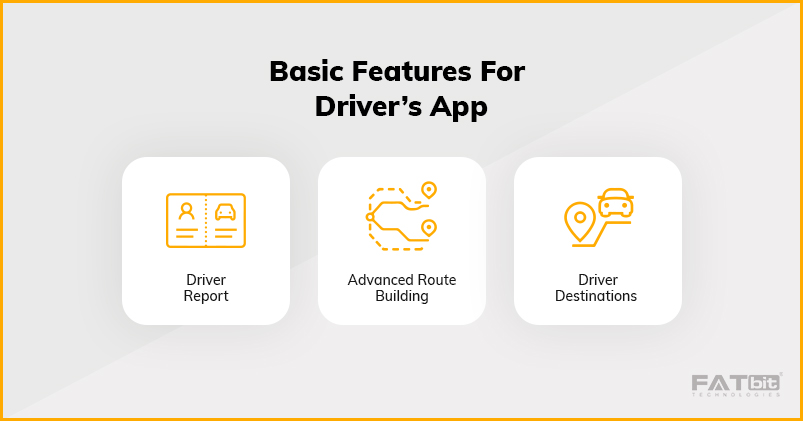
Driver Report
Driver report is an important feature from the viewpoint of both driver and rider’s safety. The report provides brief information about the driver’s driving style and obedience to traffic rules over a week/month. The platform could ban a driver if it’s found that he/she continues to drive carelessly or is involved in several driving offenses.
Advanced Route Building
The feature of route building brings that cutting edge performance in a taxi booking mobile app. It optimizes the routes that eventually contribute to the drivers’ efficiency. In the end, customers receive better service, which enables the app to increase in popularity.
Driver Destinations
To enhance the driver’s experience, the driver destination feature has become quite popular in taxi booking apps like Uber. As such it should be considered as part of the app development. The feature allows drivers to select a favorite location and find passengers looking for a ride there.
Advanced Feature For Driver’s App
Heat Maps
A Heat map can be a handy feature to have for drivers wanting to make the most of their time. The heat map can be used to view areas with the maximum ride requests. Drivers willing to make more profit can reach these locations and start taking ride requests from there.
Lastly, there’s the admin panel, which is usually web-based and calls for a certain amount of work from a web development service provider. An admin panel gives you a very clear picture of the ongoing business operations and at the same time allows you to manage payrolls and manage user-data.
Launch a Feature Rich Cab Booking App Like Uber
Pro Tips To Gain a Competitive Edge In The Taxi Booking Industry
Features aside, there needs to be something extra that users should be able to remember an app by. This makes even more sense in the online taxi booking industry where new players continue to try their ideas to experience Uber-like success. The following are some of the strategies on which business owners can work to improve their chances of success.
1. Unique Value Proposition
It’s fair to say that there’s a direct correlation between an app’s success and its end-users’ satisfaction. Based on that principle, the first thing that every cab-app service needs to tick off the box is riders and driver’s satisfaction. There are numerous ways to offer unique value to both parties:
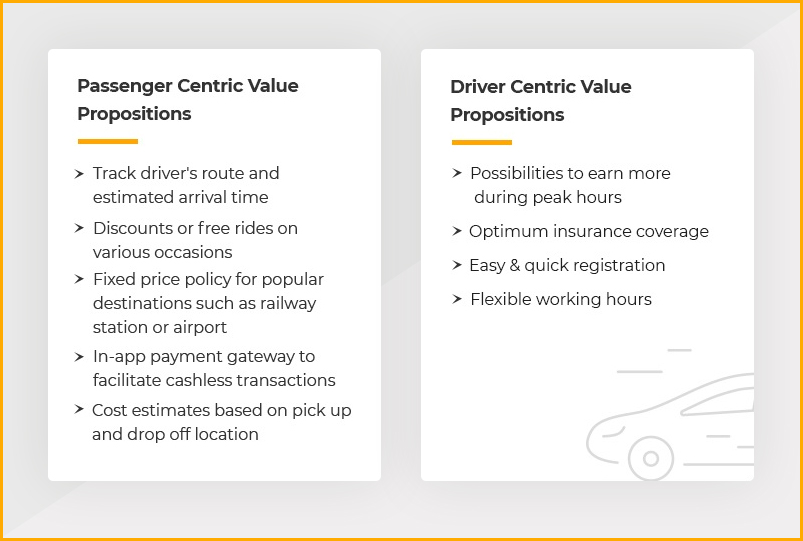
2. Consider Global Expansion
While starting small and locally is the more preferred path, if your budget allows it, an exception can be made in the taxi-booking industry. Uber’s success has proved the demand for the service is universal. Even countries where Uber faced opposition because its model was thought to be incongruent to the domestic conditions have since come to welcome the service.
What’s surprising though is that Uber still hasn’t covered every country on the globe. For instance, it’s not represented in Brunei, Malta, Iceland, Cyprus and Luxembourg for different reasons. That’s evidence enough, that the service has some roadblocks and the first business to find a way across them can expect huge rewards.
Revenue Model of Taxi Booking App Business
The revenue model defines how a business generates its income from different sources. In the taxi-booking industry, Uber’s revenue model remains the most effective and increasingly favoured among new players. Uber earns revenue through the following two sources:
- Commission from driver
- Affiliated marketing and ads for other businesses
1. Fees & Commissions
One of the main sources of revenue for Uber is the commission earned from drivers and riders. For drivers, this is charged when they accept a ride request. The commission rate tends to vary between 20-25% of the total ride cost. Additionally, Uber charges a flat booking fee from passengers.
For a more healthy revenue stream, it’s possible to add additional costs in the form of security, premier service, and easy money transactions.
Cancellation fee – Users are charged a cancellation fee in case they decide to cancel their booked rides.
2. Promotional Partnership
Given its popularity and global reach, Uber remains a top contender for promotional collaboration for mega-brands like Hilton, Pepsi, and Spotify. This is a popular marketing practice that plays to everyone’s advantage. Uber receives money for promoting other brand’s content, those brands get a wider reach and a chance to interact with their target audience. The target audience is benefited in the form of coupons, discounts, and other promotional gifts through the promotion.
3. Advertising
Advertising for local businesses is a great way to create a revenue stream. Advertised businesses can be charged on cost-per-click or cost per mile basis.
How Much Does It Cost To Build a Mobile App Like Uber?
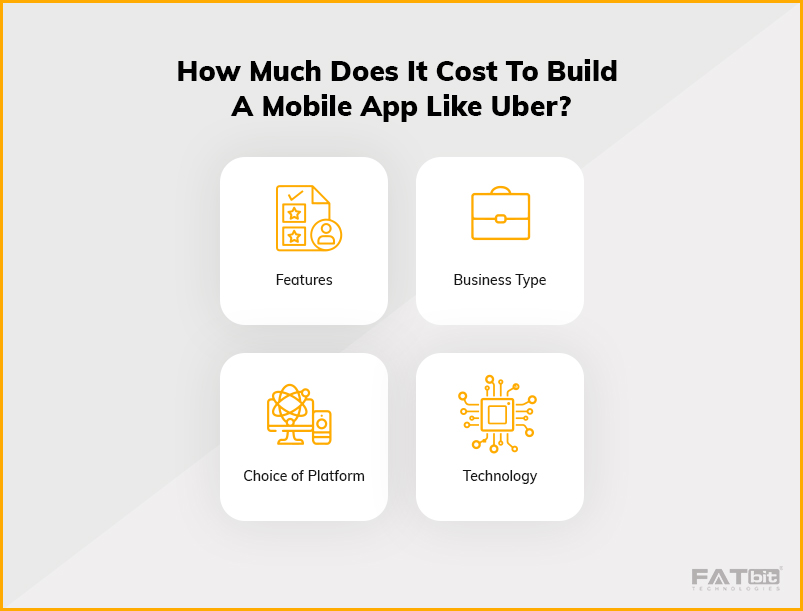
The cost to build a mobile app like Uber depends on several things. In fact, the cost can differ a lot even between two mobile app development companies in the same region based on their expertise and number of resources. Following are some of the most significant factors that impact the cost of development:
1. Features
There’s a direct correlation between a set of features and an app’s overall cost. As previously mentioned, an app can have any number of features ranging from the basic to some advanced ones. The process of building a taxi-booking mobile app usually starts with an MVP. This includes both the passenger, rider, and admin apps but with bare minimum features.
Uber started much the same way. In its initial release, the Uber app lacked any gamification features and cost splitting. It was built to accomplish one main objective, which was to connect drivers with passengers and provide a payment option within the app. Uber was able to achieve that with a promising response.
The point about an MVP is that it helps ascertain idea feasibility and gather useful early adopter’s feedback. The same can then be utilized in product improvement through useful feature addition.
2. Business Type
Where a business currently stands has a huge say on the type of solution it would opt for. For instance, a business with an existing taxi booking service would like to have mobile apps developed in line with its internal operations. This will call for a large capital investment.
On the other hand, a startup taxi booking business would look to have a mobile app developed with limited functionality just to support its short-term vision to gain traction. The cost of development is going to be relatively much cheaper in this scenario compared to the previous one.
3. Choice of Platform
Should I build for the stable iOS community or the ever-growing Android user-base? The question never seems to get old. For businesses with a limited budget, it’s always advisable to proceed with an MVP version on either platform and learn from user feedback. Uber initially built for the iOS platform since it was much popular at the time, especially in the Western world. If, however, you’ve got the budget for it, build the apps for both platforms as that will allow you to get wider coverage in any region.
4. Technology
Much like the platform, you have to decide about the technology to power your mobile apps. The choice comes down between Hybrid and Native. More often than not people opt for native app development. Hybrid is only selected by a small percentage of business owners for a specific purpose. Both hybrid and native are different in terms of the programming languages and the architecture they use.
When discussing the cost of developing an app like uber, there’s no categorical figure one can stick to. Statista provides the average rate for different locations around the world:
- North America — $60-250 per hour
- United Kingdom — $60-150 per hour
- Western Europe — $40-120 per hour
- Eastern Europe — $20-100 per hour
- India — $10-80 per hour
Just to reaffirm the point, these figures must be taken with a pinch of salt. They only reflect the averages. A comprehensive discussion about the project with a development partner can reveal additional costs.
Our Recommendation
If you are simply looking to launch an app like Uber, then there are several off-the-shelf solutions available in the market. VivoCabs is one such taxi booking solution, which was designed and developed by the team of FATbit Technologies. It is a fully customizable and scalable solution that comes with a rich suite of features like multiple payment gateways, fare estimator, geo-fencing, SOS for users, and so much more. The white-label solution also comes equipped with mobile apps for riders and drivers (Android and iOS).
Key Highlights of VivoCabs
- Cost-Effective
- GDPR Compliant
- Fully Customizable and Scalable
- Rider and Driver Apps (Android and iOS)
- Multiple Payment Gateways
- 12 Months of Free Technical Support
- Quick Time-to-Market
Build a Cab Booking Application like Uber with VivoCabs
Final Thoughts
The future of on-demand taxi-booking apps looks promising due to the growing customer demand. Although cab/taxi-booking behemoths like Uber and Lyft are firmly placed in the industry and continue to work aggressively on global expansion, there’s still plenty of room for new players to innovate. Therefore, if you are planning to launch a cab booking app like Uber, this is the right time. For more information, you can get in touch with us.
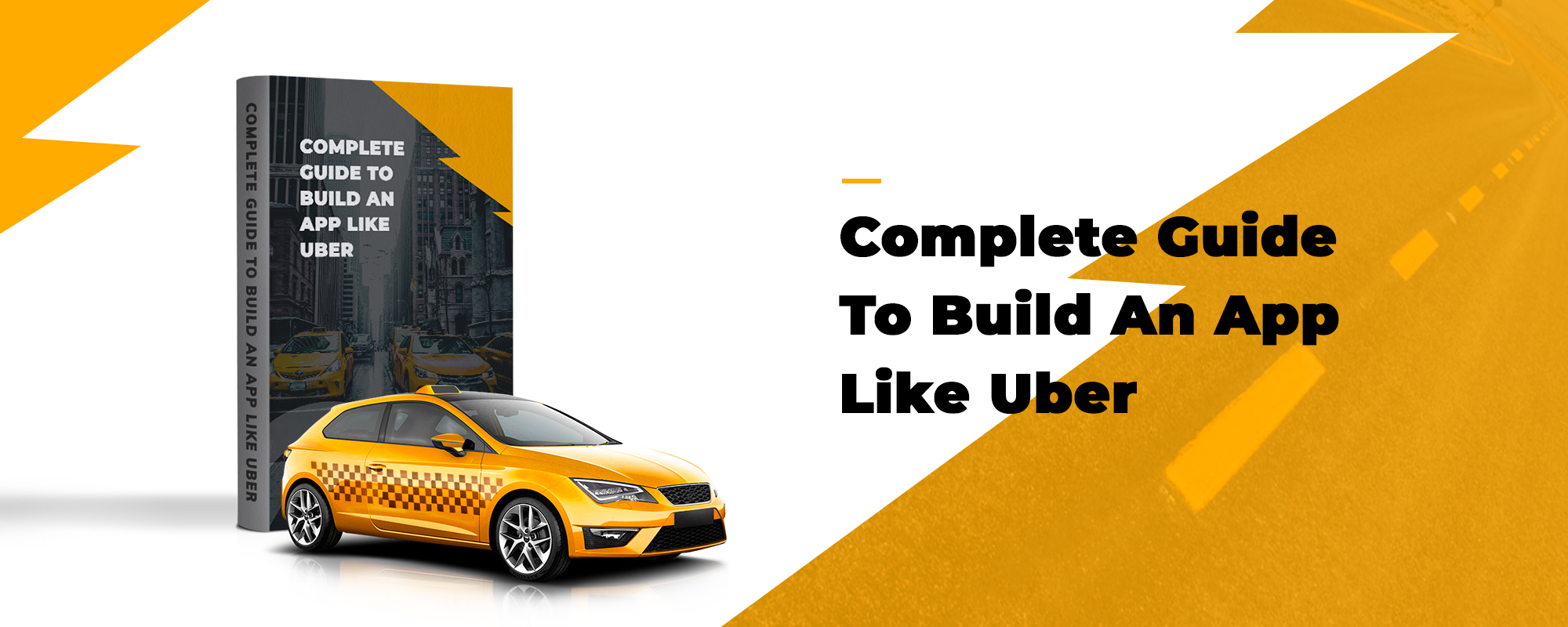

 To ensure that the customer/rider can use these services in a hassle-free manner, Uber has a very simple ride-booking process in place. Here’s how it works:
To ensure that the customer/rider can use these services in a hassle-free manner, Uber has a very simple ride-booking process in place. Here’s how it works:




Comments (2)
 leoul
leoul
 FATbit Chef
FATbit Chef
I am very happy to meet FATbit TECHNOLOGIES and to work with you.
Hello Leoul,
The pleasure is all ours. Cheers! 🙂